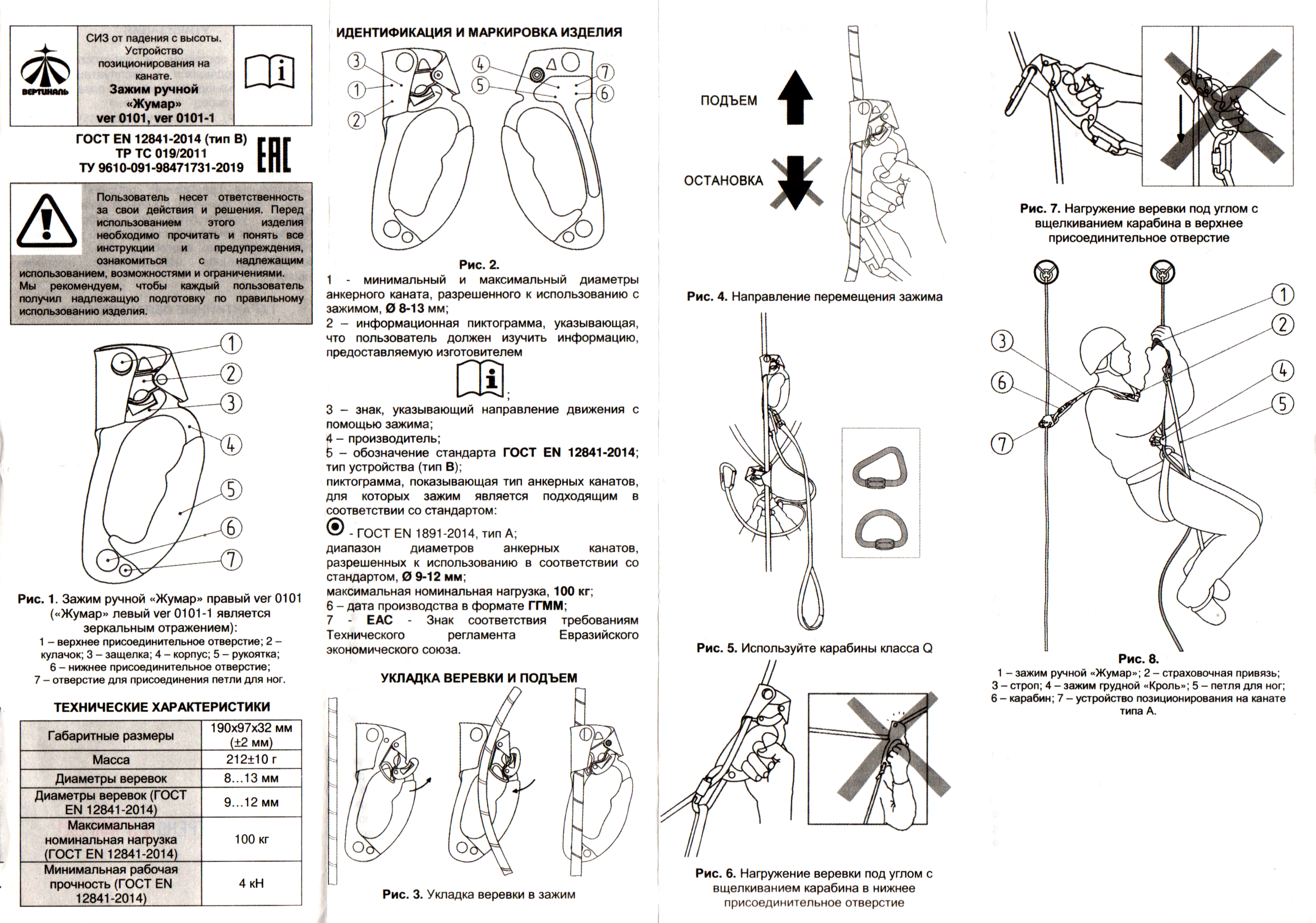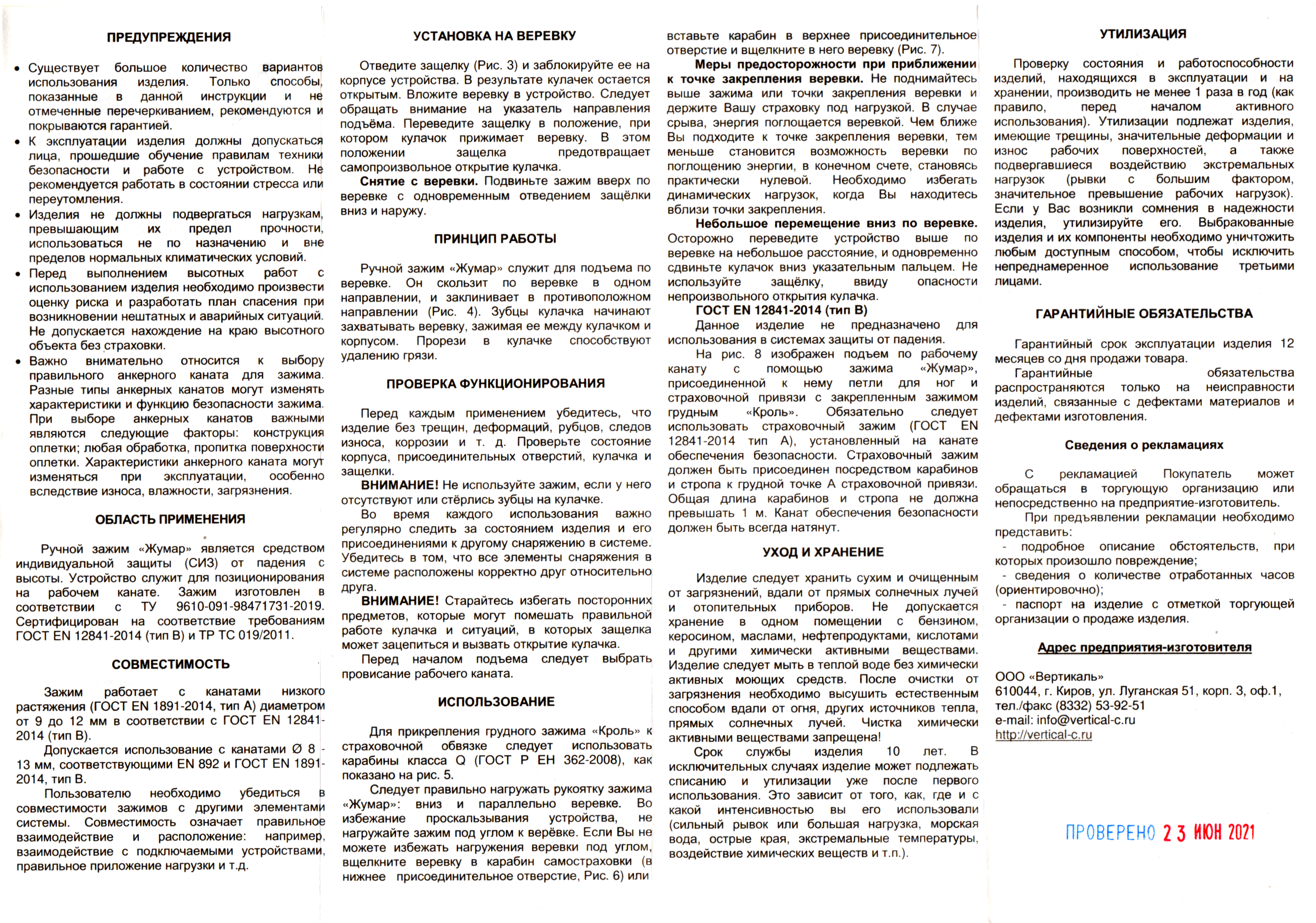Overview
[ Top
| Version B
| Version C
| Version D
| Version E
| Return to H.E.C. Ascenders
]
Version A
(a.k.a. "Kirov")
(#187)
Technical Details
I acquired this pair of ascenders in January 2005 when Serguei
Khramtsov of Ural Sport made a shopping trip through the climbing
shops of Yekaterinburg, Russia for me.
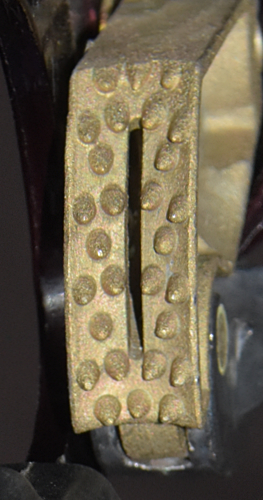 The shell is a tall irregular shaped stamping made from 3.9 mm.
aluminum alloy sheet metal. A rope channel is formed in the upper
portion of one side and a smaller cam channel lies opposite the
first. There is a stamped rib behind the cam, and grinding marks
at the base of the cam channel. A hole drilled through both sides
of the cam channel accepts a 5 mm. semi-tubular rivet. The cam, cam spring
and a washer are mounted on this rivet. The head of the rivet
sits into a depression on the front of the shell, while the roll
is exposed on the back side. The handle below the cam has a soft
black plastic hand grip molded into place. The rounded hand grip
is a synthetic rubber with one cusp to fit between the index and
ring fingers. A 15.7 mm. sling attachment hole is punched below
the handle opening and a second 10.1 mm. hole is punched beside the first. Neither hole is beveled. A subtriangular
hole through both sides of the rope channel provide an attachment
point just above the cam. This hole is 18.4 mm. high, 15.9 mm. wide,
and not beveled. It is clearly formed by milling a pattern similar
to the letter "T" lying on its side.
The shell is a tall irregular shaped stamping made from 3.9 mm.
aluminum alloy sheet metal. A rope channel is formed in the upper
portion of one side and a smaller cam channel lies opposite the
first. There is a stamped rib behind the cam, and grinding marks
at the base of the cam channel. A hole drilled through both sides
of the cam channel accepts a 5 mm. semi-tubular rivet. The cam, cam spring
and a washer are mounted on this rivet. The head of the rivet
sits into a depression on the front of the shell, while the roll
is exposed on the back side. The handle below the cam has a soft
black plastic hand grip molded into place. The rounded hand grip
is a synthetic rubber with one cusp to fit between the index and
ring fingers. A 15.7 mm. sling attachment hole is punched below
the handle opening and a second 10.1 mm. hole is punched beside the first. Neither hole is beveled. A subtriangular
hole through both sides of the rope channel provide an attachment
point just above the cam. This hole is 18.4 mm. high, 15.9 mm. wide,
and not beveled. It is clearly formed by milling a pattern similar
to the letter "T" lying on its side.
The cam is a webbed casting with a cutout behind the cam face.
The cam face is divided by a vertical slot designed to provide
clearance for mud. The conical cam teeth have their axes approximately
parallel to the lower surface of the cam. The tooth pattern is
(3)(2S1.1S1)^3(2S2)(3), where the "S"s stand for the
single longitudinal mud removal slot. The cam safety pivots on
a 5.5 mm. semi-tubular rivet that passes through the cam and spur extending
from the base of the cam casting. The safety is cast aluminum
with a pointed thumb tab. The safety pin actuates a plunger that
presses against a notch in the cam spur, much like the spring
and plunger mechanism on a traditional carabiner.
The handgrip has a logo and the word "VERTICAL" molded
into the front side.
This ascender is clearly copied from the Petzl
Ascension, Version P, even to the point of copying the uncomfortable
spur in the hand grip, but it is better made than
my earlier Russian copies. I think that
they could have eliminated the crude grinding on the frame, though.
The cam is nicely made (copying the Petzl
Ascension, Version P), and the cam safety is solid. I like
the way they attached the cam safety (the same as Petzl
Ascension, Version P), but the thumb tab is too sharp (also
like the Petzl Ascension, Version J).
I suggest rounding this. The safety operates easily with one hand,
holds the cam open well, and releases smoothly. There are no stiffening
ribs in the front strap or above the hand grip, so I would be
concerned about bending it over pit lips, just as with the Clog and other stamped frame ascenders.
Serguei referred to this ascender as the "Kirov" after its place of origin, and I originally cataloged it under that name before changing to "Vertical" and placing it with the others. He sent me a photo of it in November 2004, with the caption "Jumar made in Kirov city, it’s rather new product. It was shown on the market about one year ago." He later added, "By the way Kirov city is famous in the Ice Climbing world as the place of World championship. There are a lot of information in English in the Internet about [it]."
[ Top
| Version A
| Version C
| Version D
| Version E
| Return to H.E.C. Ascenders
]
Version B
(#2932)
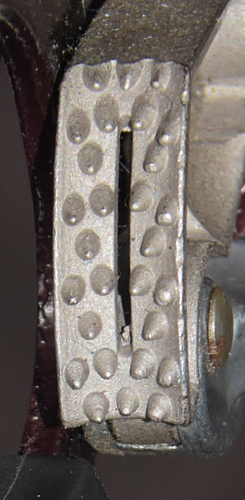 Technical Details
Technical Details
I acquired my Vertical (Вертикаль), Version B from Artyom Babin (Артём Бабин) in 2019.
This version is 196 mm. tall, 94 mm. wide, 29 mm. thick, and weighs 219 g. It differs from Version A in these ways:
- The ground area on the frame near where the cam safety latches has been eliminated.
- The cam rivet has a brazier head rather than a flat head.
- The cam rivet head is not recessed into the front of the frame.
- The end of the cam spring behind the cam is shorter and does not protrude.
- The cam spring wraps around the cam axle six times instead of seven.
The handgrip has a logo and the word "VERTICAL" molded
into the front side.
The changes are minor, but reflect better quality control on this version. In particular, better alignment of the cam axle and cam channel eliminated the need to grind the frame to provide clearance for the cam safety.
[ Top
| Version A
| Version B
| Version D
| Version E
| Return to H.E.C. Ascenders
]
Version C
(#2931)
Technical Details
I acquired my Vertical (Вертикаль), Version C from Artyom Babin (Артём Бабин) in 2019.
Version C is 196 mm. tall, 98 mm. wide, 29 mm. thick, and weighs 229 g.
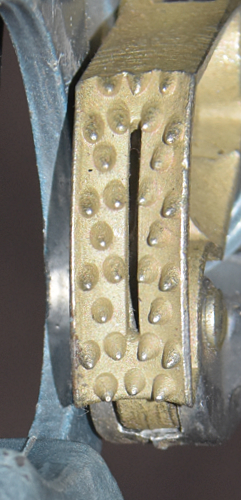 The shell is a tall irregular shaped stamping made from 3.9 mm.
aluminum alloy sheet metal. A rope channel is formed in the upper
portion of one side and a smaller cam channel lies opposite the
first. There is a stamped rib behind the cam. A hole drilled through both sides
of the cam channel accepts a 5 mm. brazier head semi-tubular rivet. The cam, cam spring
and a washer are mounted on this rivet. The head of the rivet
is on the front of the shell, while the roll
is exposed on the back side. The handle below the cam has a soft
black plastic hand grip molded into place. The rounded hand grip
is a synthetic rubber with one cusp to fit between the index and
ring fingers. A 15.7 mm. sling attachment hole is punched below
the handle opening and a second 10.1 mm. hole is punched beside the first. Neither hole is beveled. A subtriangular
hole through both sides of the rope channel provide an attachment
point just above the cam. This hole is 18.0 mm. high, 15.3 mm. wide,
and not beveled. It is clearly formed by milling a pattern similar
to the letter "T" lying on its side.
The shell is a tall irregular shaped stamping made from 3.9 mm.
aluminum alloy sheet metal. A rope channel is formed in the upper
portion of one side and a smaller cam channel lies opposite the
first. There is a stamped rib behind the cam. A hole drilled through both sides
of the cam channel accepts a 5 mm. brazier head semi-tubular rivet. The cam, cam spring
and a washer are mounted on this rivet. The head of the rivet
is on the front of the shell, while the roll
is exposed on the back side. The handle below the cam has a soft
black plastic hand grip molded into place. The rounded hand grip
is a synthetic rubber with one cusp to fit between the index and
ring fingers. A 15.7 mm. sling attachment hole is punched below
the handle opening and a second 10.1 mm. hole is punched beside the first. Neither hole is beveled. A subtriangular
hole through both sides of the rope channel provide an attachment
point just above the cam. This hole is 18.0 mm. high, 15.3 mm. wide,
and not beveled. It is clearly formed by milling a pattern similar
to the letter "T" lying on its side.
The cam is a webbed casting with a cutout behind the cam face.
The cam face is divided by a vertical slot designed to provide
clearance for mud. The conical cam teeth have their axes approximately
parallel to the lower surface of the cam. The tooth pattern is
(3)(2S1.1S1)^3(2S2)(3), where the "S"s stand for the
single longitudinal mud removal slot. The cam safety pivots on
a 5.5 mm. semi-tubular rivet that passes through the cam and spur extending
from the base of the cam casting. The safety is cast aluminum
with a pointed thumb tab. The safety pin actuates a plunger that
presses against a notch in the cam spur, much like the spring
and plunger mechanism on a traditional carabiner.
The handgrip has a logo and the word "VERTICAL" molded
into the front side.
The main difference between Version C and B is that the Version C handgrip is painted along with the frame.
[ Top
| Version A
| Version B
| Version C
| Version E
| Return to H.E.C. Ascenders
]
Version D
(#3577)
Technical Details
Artyom Babin (Артём Бабин) sent me this Vertical (Вертикаль), Version C in 2019.
The Vertical (Вертикаль), Version D is 192 mm. tall, 93 mm. wide, 30 mm. thick, and weighs 227 g.
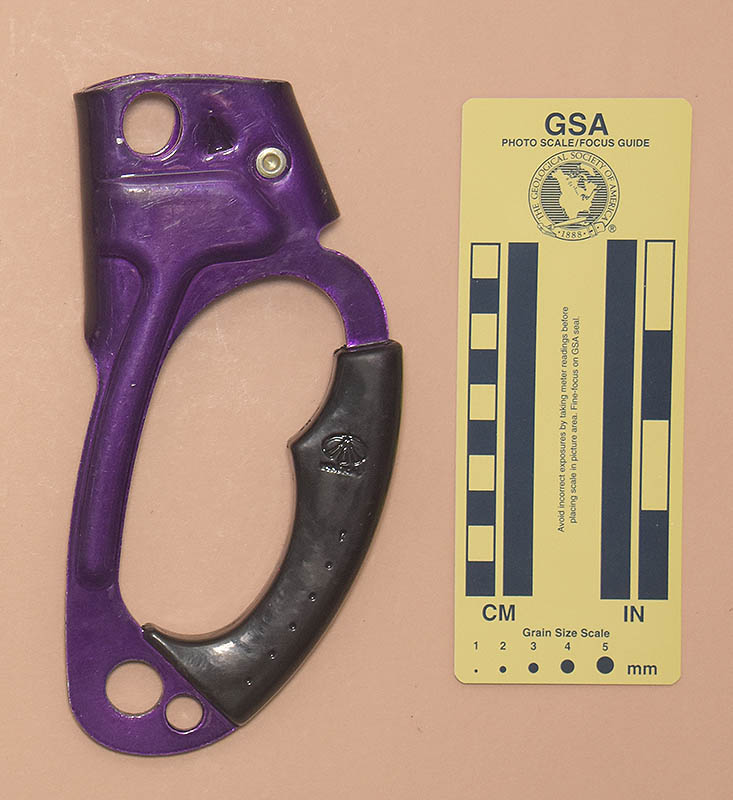 The shell is a tall irregular shaped stamping made from 4.0 mm. aluminum alloy sheet metal. A 15 mm. wide rope channel
is formed in the upper portion of one side and a smaller cam channel
lies opposite the first. A hole drilled through both sides of
the cam channel accepts a 6 mm. semi-tubular rivet. The cam and cam spring
are mounted on this rivet. The cam axle is centered 48 mm. from the inside of the rope channel. The handle below the cam has a soft
"rubbery" hand grip molded into place. The hand grip
has a slight break to support the index finger. A 16 mm.
sling attachment hole is punched below the handle opening, and
a 10 mm. hole is punched below and outside the first. A
16 by 18 mm. oval hole punched through both sides
of the rope channel provides an attachment point just above the
cam. There is a cam stop punched beside this hole.
The shell is a tall irregular shaped stamping made from 4.0 mm. aluminum alloy sheet metal. A 15 mm. wide rope channel
is formed in the upper portion of one side and a smaller cam channel
lies opposite the first. A hole drilled through both sides of
the cam channel accepts a 6 mm. semi-tubular rivet. The cam and cam spring
are mounted on this rivet. The cam axle is centered 48 mm. from the inside of the rope channel. The handle below the cam has a soft
"rubbery" hand grip molded into place. The hand grip
has a slight break to support the index finger. A 16 mm.
sling attachment hole is punched below the handle opening, and
a 10 mm. hole is punched below and outside the first. A
16 by 18 mm. oval hole punched through both sides
of the rope channel provides an attachment point just above the
cam. There is a cam stop punched beside this hole.
The cam is a plated skeletonized steel casting. The cam radius increases from 38 to 55 mm. over an angle of 32°, giving a 34° cam angle. The cam has number of small conical teeth.
The
teeth have their axes sloping downward. The tooth pattern is (3.4)(1S1.2S2)^2(1S1)^2(3)
where the S stands for a single slot.
A "rubbery" spring-loaded manual safety is riveted to the cam. The
normal action of the spring holds the safety against the cam.
When the cam is opened, the shell interferes with the safety,
thus preventing opening the cam. If the safety is moved away
from the cam (opposing the spring), it will clear the shell and
the cam will open. At full open the safety can be released and
the spring will hold the safety against the back of the shell.
This provides a means of locking the cam open.
The front of the right-handed ascenders are printed with "Ø8-12," a rigging illustration, a РСТ logo, and "ΑΓ13." The of the right-handed ascenders are printed with the Vertical logo, "VERTICAL," and "1612." The right-handed ascender is newer and the printing reflects more recent testing. The front is printed with "Ø8-13," a rigging illustration, and a book-with-an-"i" icon. The rear is printed with the Vertical logo, "VERTICAL," "EAC," "ГОСТ EN 12841-2014:B•Ø9-12 мм 100 кг," and "21.04" (the date of manufacture)
The handgrip has a logo and the word "VERTICAL" molded
into the rear side.
This version introduces a new cam and a plastic cam safety. This version differs from Version E by being painted purple and having the logo and the word "VERTICAL" molded
into the handgrip.
[ Top
| Version A
| Version B
| Version C
| Version D
| Return to H.E.C. Ascenders
]
Version E
(#2311, 2376)
Technical Details
I acquired a right-handed Vertical (Вертикаль) from Ice Rock in 2017, and a second right-handed one from Artyom Babin (Артём Бабин) in 2019. Артём helped me get a left-handed ascender from Vertical in 2022.
The Vertical is 192 mm. tall, 94 mm. wide, 28 mm. thick, and weighs 208 g.
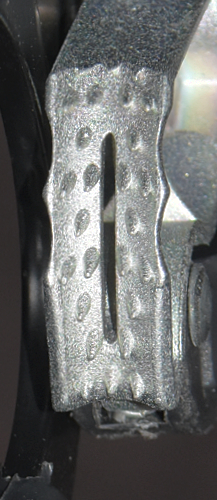 The shell is a tall irregular shaped stamping made from 4.0 mm. aluminum alloy sheet metal. A 16 mm. wide rope channel
is formed in the upper portion of one side and a smaller cam channel
lies opposite the first. A hole drilled through both sides of
the cam channel accepts a 6 mm. semi-tubular rivet. The cam and cam spring
are mounted on this rivet. The handle below the cam has a soft
"rubbery" hand grip molded into place. The hand grip
has a slight break to support the index finger. A 15.9 mm.
sling attachment hole is punched below the handle opening, and
a 10.3 mm. hole is punched below and outside the first. A
15.9 by 17.7 mm. oval hole punched through both sides
of the rope channel provides an attachment point just above the
cam. There is a cam stop punched beside this hole.
The shell is a tall irregular shaped stamping made from 4.0 mm. aluminum alloy sheet metal. A 16 mm. wide rope channel
is formed in the upper portion of one side and a smaller cam channel
lies opposite the first. A hole drilled through both sides of
the cam channel accepts a 6 mm. semi-tubular rivet. The cam and cam spring
are mounted on this rivet. The handle below the cam has a soft
"rubbery" hand grip molded into place. The hand grip
has a slight break to support the index finger. A 15.9 mm.
sling attachment hole is punched below the handle opening, and
a 10.3 mm. hole is punched below and outside the first. A
15.9 by 17.7 mm. oval hole punched through both sides
of the rope channel provides an attachment point just above the
cam. There is a cam stop punched beside this hole.
The cam is a plated skeletonized steel casting. The cam radius increases from 38 to 55 mm. over an angle of 32°, giving a 34° cam angle. The cam has number of small conical teeth.
The
teeth have their axes sloping downward. The tooth pattern is (3.4)(1S1.2S2)^2(1S1)^2(3)
where the S stands for a single slot.
A "rubbery" spring-loaded manual safety is riveted to the cam. The
normal action of the spring holds the safety against the cam.
When the cam is opened, the shell interferes with the safety,
thus preventing opening the cam. If the safety is moved away
from the cam (opposing the spring), it will clear the shell and
the cam will open. At full open the safety can be released and
the spring will hold the safety against the back of the shell.
This provides a means of locking the cam open.
The front of the right-handed ascenders are printed with "Ø8-12," a rigging illustration, a РСТ logo, and "ΑΓ13." The of the right-handed ascenders are printed with the Vertical logo, "VERTICAL," and "1612." The right-handed ascender is newer and the printing reflects more recent testing. The front is printed with "Ø8-13," a rigging illustration, and a book-with-an-"i" icon. The rear is printed with the Vertical logo, "VERTICAL," "EAC," "ГОСТ EN 12841-2014:B•Ø9-12 мм 100 кг," and "21.04" (the date of manufacture).
These are well-made ascenders and
perform much like the Petzl Ascension.
All sharp edges have been removed. The attachment points are simple
holes in the shell. They are not rounded but the owner could round them with a Swiss file.; even so, I would consider
their small radius too sharp for directly attaching sling ropes.
They are probably acceptably rounded for webbing, but considering
the proximity of the attachment points to the main rope, I would
recommend using a small maillon for most attachments in order
to reduce the risk of sling abrasion. The lower attachment hole
could theoretically have the same safety problems as the one on
Clog Version A. The upper rope attachment
hole is located very close to the main rope. A carabiner through
the upper attachment hole will probably drag on the main line.
Note that such a carabiner will prevent putting the ascender on
or off rope, so one’s climbing system must be designed accordingly.
The safety is easy to use with one hand but rather painful, having a sharp point that effectively stabs the meat of the thumb. It reminds
me of the one on a recent Petzl Ascension that was equally painful. Once again, a file easily removes the problem.
The rubber handle grips are not particularly comfortable for me because the rib is spaced
poorly for my large hands.
The cam is well made. It has an extra opening in the web that is not found on earlier versions. The cam stop is placed in a position
where it will actually touch the cam if the ascender is off rope.
Many manufacturers put cam stops in odd places where they can
never touch the cam. I don't see much need for cam stops, most
active cavers don't weight enough to bend their ascenders to failure
by cam pull-through, and there is no need to shock load one’s
ascenders.
This ascender has the same pit lip disadvantage as the
Clog and other stamped frame ascenders,
although the reinforcing will help prevent bending.
I'm not sure the extra holes are needed at the base. Except for the Petzl Pompe, I've never found a real need for a second hole. Some people like them, and I might find them more appealing if they were large enough for a standard carabiner to fit through.
[ Top
| Version A
| Version B
| Version C
| Version D
| Version E
]



